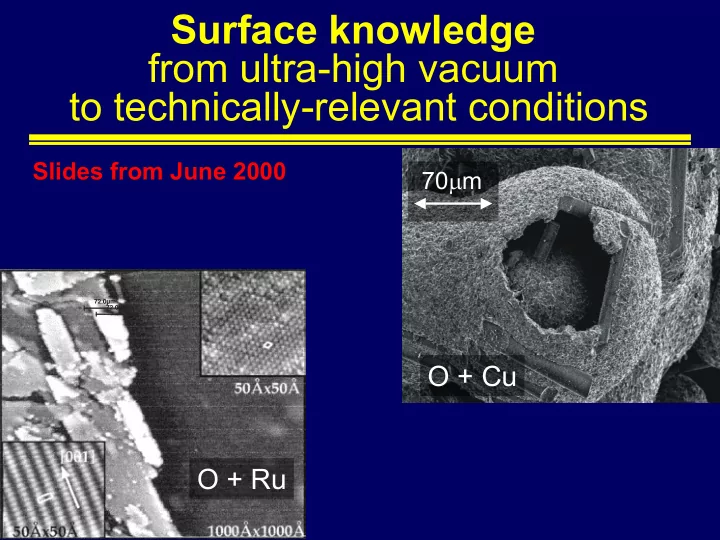

Surface knowledge from ultra-high vacuum to technically-relevant conditions Slides from June 2000 70 µ m O + Cu O + Ru
Surface knowledge from ultra-high vacuum to technically-relevant conditions 70 µ m Matthias Scheffler Fritz-Haber-Institut der MPG, Berlin in collaboration with: Xiao-Gang Wang, O + Cu Catherine Stampfl, Karsten Reuter, Artur Böttcher, O + Ru Robert Schlögl
part one: Oxidation Catalysis, mainly Ru and RuO2 under high O2 and CO pressure --removed--
Commercial Process of Styrene Production Dehydrogenation of Ethylbenzene to Styrene C 6 H 5 CH 2 CH 3 C 6 H 5 CH=CH 2 + H 2 ( ∆ H 0298 = 124.9 kJ/mol ) Parameters of the commercial process: • reaction temperature: 580-640°C • pressure: atmospheric • component of feed gas: H 2 O / EB = 6 / 9 • selectivity to styrene: 95%
Catalytic Activity Styrene Production Rate (%) 5 K Fe x O y 3,5 4 3 3 2,5 3 2 2 1,5 Fe 2 O 3 2 1 1 0,5 1 0 0 0 Fe 3 O 4 Fe 2 O 3 K Fe x O y 0 40 80 120 160 Time (min)
Stoichiometry and Structure of the Surface depend on the Environment (atomic chemical potentials) E surface = E total - N O µ O - N Fe µ Fe O 2 gas 2 m Fe + 3 m O = E bulk (Fe 2 O 3 ) surface Fe 2 O 3 substrate
Fe 2 O 3 (0001) Surface Terminations O 3 FeFe- R Surface energy (meV/Å 2 ) FeO 3 Fe- R O 2 FeFe- R FeFeO 3 - R -3.0 -2.0 -1.0 0.0 Oxygen chemical potential (eV) O 1 FeFe- R X.G. Wang et al., PRL 81 (1998)
Fe 2 O 3 (0001) O-terminated Surface O Fe X.G. Wang et al., PRL 81 (1998)
The Role of Carbon Desorption of Ethylbenzene • The surface is fully covered 3.83 L with carbon (and oxygen) 3.22 L 2.58 L • Ethylbenzene does not 1.29 L interact with iron oxide 0.64 L 0.32 L • Thus, the catalytic activity 0.16 L is not related to Fe-oxide 100 300 500 Temperature (K) So, what is the C. Kuhrs and R. Schlögl, active catalyst? to be published
Carbon Nanotubes for EB Conversion 1.0 1 0 0 Selectivity to 9 0 S e le ctivity to S T 0.8 Styrene: 100% 8 0 7 0 0.6 6 0 % 5 0 0.4 4 0 S T yie ld Styrene yield: 50% 3 0 0.2 2 0 1 0 0.0 0 1 7 3 4 5 1 6 8 8 5 1 0 2 1 1 9 1 3 6 1 5 3 17 51 85 119 153 T im e , m in Time (min) R. Schlögl et al., to be published Reaction temperature 450°C Concentration of ethylbenzene in the stream 1·10 -5 mol/ml Flow of the stream 10 ml/min
Conclusions • The technique of calculating free energies and predicting the lowest-energy structures in equilibrium with multiple species in the environment is applicable to a wide variety of gas-phase and solution-phase chemistry. • The ideal models are re-structured and the composition is changed into the suitable real structure (new material). This happens with a "fast" kinetics only at "high" temperature and pressure. • Complexity is essential for understanding the function of surfaces.
Some references ( updated: Jan. 2002 ) • N. Keller et al., Angew. Chem., in print (2002): The Catalytic Use of Onion-Like Carbon Materials for the Styrene Synthesis by Oxidative Dehydrogenation of Ethylbenzene. • X.-G. Wang, W. Weiss, Sh.K. Shaikhutdinov, M. Ritter, M. Petersen, F. Wagner, R. Schlögl, and M. Scheffler, Phys. Rev. Lett. 81 , 1038 (1998): The hematite (Alpha- Fe 2 O 3 )(0001) surface: Evidence for domains of distinct chemistry . • R. Schloegl, CATTECH 5 (3) , 146 (2001): Theory in heterogeneous catalysis. An experimentalist's view.
• S. Strano, Jane Rempel, John Halverson, Chris Burket, Jonathan Mathews and Henry C. Foley, in print (2002): Structural modeling of nanoporous carbon: A review of approaches to simulating an aperiodic and non- equilibrium solid. • K. Reuter and M. Scheffler, Phys. Rev. B 65 , 035406 (2002). Composition, structure, and stability of RuO 2 (110) as a function of oxygen pressure (11 pages). • S. Wilke, M.H. Cohen, and M. Scheffler, Phys. Rev. Lett. 77 , 1560-1564 (1996): Local reactivity of solid surfaces ,
• Michael S. Kane, Lien C. Kao, Ravindra K. Mariwala, David F. Hilscher, and Henry C. Foley, Ind. Eng. Chem. Res. 35, 3319 (1996): Effect of porosity of carbogenic molecualar sieve catalysts on ethylbenzene oxidative dehydrogenation. • V. Petkov, R.G. DiFrancesco, S.J.L. Billinge, M. Acharya and H.C. Foley, Philosophical Magazine B 79, 1519 (1999): Local structure of nanoporous carbons. • Madhaw Acharya, Michael S. Strano, Jonathan P. Mathews, Simon J.L. Billinge, Valeri Petkov, Shekhar Subramoney, and Henry C. Foley, Philosophical Magazine B 79,1499 (1999): Simulation of nanoporous carbons: a chemically constrained structure.
Recommend
More recommend